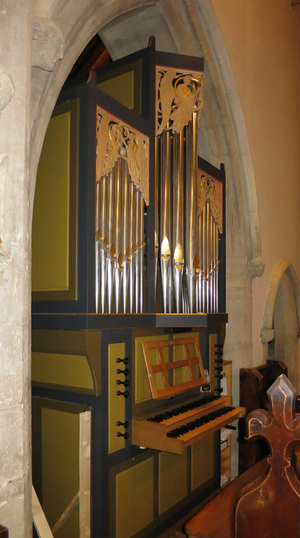
“What kind of organ would you like to commission, Reverend Hewetson?” “One that fits under the arch,” was the reply. It was a practical dialogue along these lines in 1990 between the Revd Christopher Hewetson (HT’s vicar from 1990 to 1995) and the late Kenneth Tickell, organ master and builder, that led to the graceful and harmonious instrument that we have now.

Not forgetting the role of the curate Elias Polomski (also the creator of the altar tapestry), who designed the angels who float above the organ pipes. The old organ, which was built in 1911, stood under the arch where our current organ is now. Fr Head, the incumbent before Fr Chris, knew his way around the instrument but it was bulky and missing notes, and something had to be done.
The pipes and woodwork of this mammoth jutted out into the Lady Chapel, which had become little more than a passageway into the 1970s vestry. Another drawback was that its ungainly mass blocked the arch – if you look, you’ll see that there is now light and space between the stonework and the angels that adorn the central pipes of our instrument.
Fr Chris was a man of action and did not wait around for the two years it would take the new organ to be built. Once he had agreement to invest in a new one, the old organ (“that dreadful old thing” says Anon, who knew it too well) and had decided on Kenneth Tickell as his organ builder, he could leave it to the professionals. Tickell’s construct classic organs suitable for English baroque music. Their pipework is ‘incisive’, which means that the organists have to be good because they can’t cover up their mistakes with a wall of mushy sound. So the old piece was dismantled, and its pipes and woodwork distributed throughout the parish. A temporary organ was hired from Russell Acott in the High, together with a student to play it, while Kenneth Tickell got to work. (His workshop was then in an old bakery in Northampton, with the Hovis sign still in place.)
New organs don’t come cheap but Holy Trinity had just been blessed with a legacy for £51,000. There was £35,000 left over after the Narnia Window and repairs to the roof. An electronic organ was a definite option because it would have been much less expensive than a traditional air-powered design but Fr Chris was advised that no organist in Oxford – a city filled with church music and musical scholarship – would cross the road to play a mechanical instrument (“they make a tinny sound,” comments Anon). But a mechanical organ (known as a ‘track action’ organ) would attract true organists from miles around to play it. And so it has.
Expense was not the only factor. The constraints of fitting a smaller instrument under the arch and still filling the church with rich sound meant compromises. “Louder and larger would have been nice,” says Fr Chris, “but that would have meant another six inches on the back of the organ.”
Our instrument is designed for baroque music. It is perfectly possible to create Romantic and other non-baroque sounds with it but our then-organist Sarah Lister generally played for us what our organ does best. It has no oboes, clarinets or trombones, which excludes much of the French repertoire, and brides have to make do without trumpets, but it has two manuals (the keyboards), where many small organs have only one. The biggest sacrifice to cost is arguably the lack of swell pedal, the device that allows the organist to flood the space with sound – but there was no swell pedal at the time of Bach either.
The virtues of our beautiful instrument is that it is a not only a joy to look at but a joy to play. Some organs need determination to get the keys to sound, rather like hammering at an old manual typewriter: our instrument is not only in good repair – a blessing for any travelling organist; but it is extremely responsive (which is another way of signalling that the organist has to be good or you get notes the composer did not write).
If you would like to read more, you can check out the Tickell company’s website. There is also a Tickell organ at our neighbouring Headington church, St Andrews.
